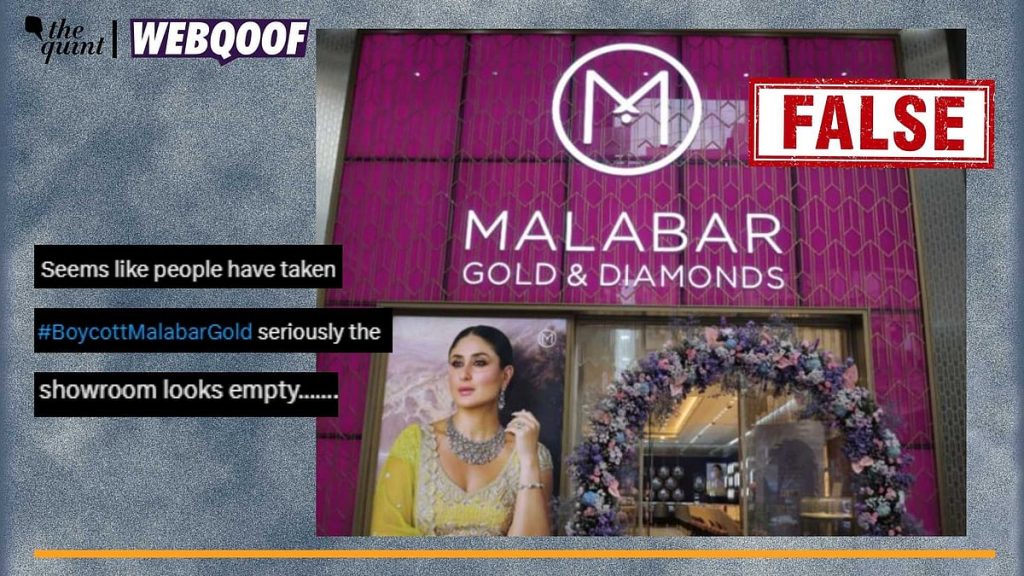Listen to the article
Viral Image of Empty Malabar Gold Showroom Misleadingly Linked to Recent Boycott Calls
A photograph purportedly showing an empty Malabar Gold & Diamonds showroom has been circulating widely across social media platforms, incorrectly presented as evidence that recent boycott calls against the jewelry retailer have been successful.
The viral image, which has garnered over 30,000 views on one platform alone, is being shared with captions suggesting immediate impact from the boycott movement. “Seems like people have taken #BoycottMalabarGold seriously the showroom looks empty… Will you support this????” reads one typical caption accompanying the photograph.
However, fact-checking reveals the image is not recent and predates the current controversy by a significant margin. The photograph can be traced back to at least October 2022, making its connection to any current boycott campaign misleading and factually inaccurate.
The current boycott calls against Malabar Gold & Diamonds emerged in recent weeks amid a broader pattern of targeted social media campaigns against various brands in India. These boycott movements typically gain traction quickly on platforms like Twitter, Facebook, and WhatsApp, where context can be easily stripped from visual content.
Malabar Gold & Diamonds, founded in 1993, has grown to become one of India’s largest jewelry retailers with over 300 showrooms across ten countries. The brand has expanded significantly in the last decade, particularly in Gulf Cooperation Council (GCC) countries where there is substantial demand for gold jewelry among both the local population and the large Indian diaspora.
The jewelry retail sector in India represents a significant economic force, with gold holding particular cultural importance in weddings, festivals, and as a form of investment. Industry analysts value the Indian jewelry market at approximately $75 billion, making it the second-largest consumer of gold globally after China.
Social media boycott campaigns against businesses have become increasingly common in India’s digital landscape. Marketing experts note these movements often follow a predictable pattern: an initial triggering event or allegation, rapid amplification through hashtags, and the circulation of visual “evidence” that may or may not be verified or current.
“What we’re seeing is the weaponization of consumer sentiment through misleading visual narratives,” explains Dr. Anita Sharma, a digital media researcher at Delhi University. “Old images presented as current can create a false impression of immediate impact, which itself can influence consumer behavior.”
The practice of repurposing old images to support current narratives represents a growing challenge for brands, consumers, and media literacy advocates. Digital forensics experts recommend that social media users verify the timing and context of images before accepting them as evidence of contemporary events.
This incident highlights the importance of digital literacy in an era where visual content can be easily divorced from its original context and repurposed to support various narratives. For businesses like Malabar Gold & Diamonds, such misleading campaigns can potentially impact consumer perception and market performance, regardless of their basis in fact.
Industry bodies like the All India Gem and Jewellery Domestic Council have previously expressed concern about the impact of misinformation on the jewelry sector, which employs millions across the country and represents a significant portion of India’s retail economy.
As the festival and wedding seasons approach – traditionally strong periods for jewelry sales in India – retailers including Malabar Gold & Diamonds will likely be monitoring the potential impact of such social media campaigns closely, while emphasizing factual customer communication to counter misinformation.
For now, the circulation of this dated image as “evidence” of a successful boycott serves as a reminder of how easily visual content can be recontextualized in today’s digital environment, and the importance of verification before accepting such claims at face value.
Verify This Yourself
Use these professional tools to fact-check and investigate claims independently
Reverse Image Search
Check if this image has been used elsewhere or in different contexts
Ask Our AI About This Claim
Get instant answers with web-powered AI analysis
Related Fact-Checks
See what other fact-checkers have said about similar claims
Want More Verification Tools?
Access our full suite of professional disinformation monitoring and investigation tools




5 Comments
The rapid spread of this outdated photo highlights the importance of critical thinking on social media. Boycotts can be complex, so I’d encourage looking beyond sensationalized images to understand the nuances of the current situation.
Boycott movements can gain momentum quickly online, but it’s crucial to separate fact from fiction. This old photo doesn’t seem to reflect the current situation – it’s important to look at the big picture and not jump to conclusions.
Interesting to see the viral image circulating, but it’s important to verify the context. Old photos can be misleading, especially in the age of social media. I hope the current boycott calls are based on facts rather than unrelated imagery.
Targeted social media campaigns against brands can be powerful, but verifying the facts is essential. This viral image appears to be outdated, so I’m curious to learn more about the current status of the Malabar Gold boycott efforts.
While boycotts can be an expression of consumer sentiment, it’s vital to ensure the claims are accurate. This old photo doesn’t seem relevant to the recent controversy, so I hope the focus remains on the substantive issues at hand.